
|
Many baby boomers grew up on, or dreamed of owning a Schwinn bicycle. Shrewd marketing aimed at kids through Captain Kangaroo, Boys Life and various comic books left us craving a steady stream of Schwinn design breakthroughs including balloon tire 26" cruisers, 20" Sting Rays, and multi-speed 27" Varsities and Continentals. But instead of Schwinn's magic rolling on into the bike boom of the early seventies, their unique "electro-forged" (E/F) frames--the basis of our earlier favorites--were suddenly perceived as heavy, and fell from grace with maturing young riders. The steady infiltration of European and high-quality Japanese lightweight lugged frames doomed the E/F frames that made Schwinn famous. Never mind that some of the new "lightweight" lugged frames weighed as much as a Schwinn; it was trendy to own a bicycle with a foreign name and a lugged frame.
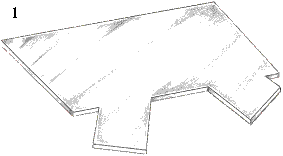 Schwinn's fall from favor was both ironic and financially devastating. In the late sixties Schwinn invested heavily in the E/F machinery--machinery vastly more expensive to build and operate than required by lug frame fabricators. During the bike boom years Schwinn was building more than a million E/F frames and bicycles every year. At the same time, though, Schwinn revived one of its old trade names and began to import the "World" line of lugged frame bicycles from National and Bridgestone of Japan rather than build them in their own Chicago plant. [Note: Between 1971 and 1979, Bridgestone built almost 1 million bikes for Schwinn--about 4.5 times the number of bikes Bridgestone-Japan built in during the Bridgestone years of 1984-1994--Grant Petersen]. This, or course, only enhanced the reputation of the lugged frame and speeded the demise of the E/F frame. Schwinn didn't start making its own lugged frames until the late seventies. Brazing with lugs wasn't new to Schwinn, which had been producing the handbuilt Paramount line of racing and touring machines, with elegantly carved and hand brazed joints, since 1938, and these frames were regarded as among the best built anywhere in the world. But the lugged technology never moved into mass production.
Schwinn's fall from favor was both ironic and financially devastating. In the late sixties Schwinn invested heavily in the E/F machinery--machinery vastly more expensive to build and operate than required by lug frame fabricators. During the bike boom years Schwinn was building more than a million E/F frames and bicycles every year. At the same time, though, Schwinn revived one of its old trade names and began to import the "World" line of lugged frame bicycles from National and Bridgestone of Japan rather than build them in their own Chicago plant. [Note: Between 1971 and 1979, Bridgestone built almost 1 million bikes for Schwinn--about 4.5 times the number of bikes Bridgestone-Japan built in during the Bridgestone years of 1984-1994--Grant Petersen]. This, or course, only enhanced the reputation of the lugged frame and speeded the demise of the E/F frame. Schwinn didn't start making its own lugged frames until the late seventies. Brazing with lugs wasn't new to Schwinn, which had been producing the handbuilt Paramount line of racing and touring machines, with elegantly carved and hand brazed joints, since 1938, and these frames were regarded as among the best built anywhere in the world. But the lugged technology never moved into mass production.
In the value-conscious 90's, collectors, hobbyists, and nostalgia buffs are rediscovering the uniqueness and enduring quality of the Schwinn-built E/F frame. Grant and I thought it might be an interesting time to pause (before we all forget) and review its unique technology in depth. What follows is a detailed description of the Schwinn E/F frame building process.
![]()
![]()
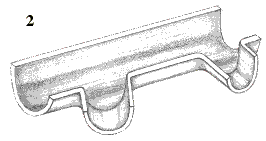 In today's bicycle manufacturing climate it is easy to forget just how unique Schwinn's production facility and frames were. Now a frame manufacturer buys tubing from one source, frame fittings from others, then fabricates a frame. Sometimes even frame subassemblies and paint work are sourced out. But Schwinn performed virtually all the operations to produce a frame in house. Schwinn made the tubing, made the frame fittings, joined the tubes and fittings into a frame and painted it. The only products Schwinn bought were coils of 1010 steel strip.
In today's bicycle manufacturing climate it is easy to forget just how unique Schwinn's production facility and frames were. Now a frame manufacturer buys tubing from one source, frame fittings from others, then fabricates a frame. Sometimes even frame subassemblies and paint work are sourced out. But Schwinn performed virtually all the operations to produce a frame in house. Schwinn made the tubing, made the frame fittings, joined the tubes and fittings into a frame and painted it. The only products Schwinn bought were coils of 1010 steel strip.
Before the E/F frames, Schwinn was fillet-brazing and welding joints by hand, then grinding and polishing them until the frame seemed carved from a block of steel. The E/F frame sought to mimic a handbuilt, fillet-brazed frame while dramatically reducing manufacturing costs. To achieve this look, Schwinn engineers actually moved the "joints" from their typical locations at the ends of the mitered tubes to a circumferential butt joint around the tube about 1 1/2" from the typical joint locations: the "head tube" actually extends out to the joint on the top tube and down tube.
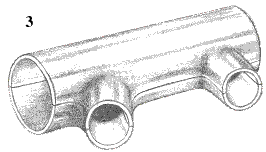 To produce a typical E/F frame joint, the ends of two tubular frame components were held nearly together and clamped in copper jaws, which acted as anodes and cathodes. The edges of the adjacent parts served as electrodes and filler material. The edges had to be closely aligned to assure a strong joint and to avoid undercutting when they were polished afterward. Then a high electric current was applied across the two parts, jumping the small gap between them. The relatively thin edges of the tubes became molten and the two parts were pushed together by hydraulic rams, amid a shower of sparks. This left heavy slag around the joint, but that was removed by belt sanders, lathes or scarfing pliers. During the joining process, nearly 3/16" of adjoining material was burned away! The actual welding took only a few seconds compared to several minutes to weld or braze each conventional joint. With potential cost savings such as this coming into view, it must have been exciting times at the Schwinn factory!
To produce a typical E/F frame joint, the ends of two tubular frame components were held nearly together and clamped in copper jaws, which acted as anodes and cathodes. The edges of the adjacent parts served as electrodes and filler material. The edges had to be closely aligned to assure a strong joint and to avoid undercutting when they were polished afterward. Then a high electric current was applied across the two parts, jumping the small gap between them. The relatively thin edges of the tubes became molten and the two parts were pushed together by hydraulic rams, amid a shower of sparks. This left heavy slag around the joint, but that was removed by belt sanders, lathes or scarfing pliers. During the joining process, nearly 3/16" of adjoining material was burned away! The actual welding took only a few seconds compared to several minutes to weld or braze each conventional joint. With potential cost savings such as this coming into view, it must have been exciting times at the Schwinn factory!
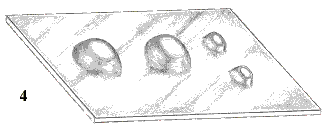 The head tube, BB assemblies, and wheel rims were made by E/F, too. The head tube began as coiled strip stock, wide enough to accommodate the top tube and downtube extensions. The strip steel was stamped to form head tube halves which were joined by E/F to form the head tube, complete with tube extensions. [Figures 1-3 above]
The head tube, BB assemblies, and wheel rims were made by E/F, too. The head tube began as coiled strip stock, wide enough to accommodate the top tube and downtube extensions. The strip steel was stamped to form head tube halves which were joined by E/F to form the head tube, complete with tube extensions. [Figures 1-3 above]
![]()
![]()
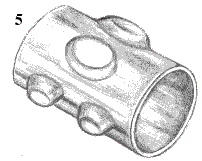 In a similar way, the BB shell began as steel strip and in its finished form extended out along the downtube, seat mast and chainstays. The extensions were punched on the strip in the eventual locations for the downtube, seat mast and chainstay joints. The still-flat shell was then rolled and the two adjoining edges were E/F'd together. (Figures 4-5)
In a similar way, the BB shell began as steel strip and in its finished form extended out along the downtube, seat mast and chainstays. The extensions were punched on the strip in the eventual locations for the downtube, seat mast and chainstay joints. The still-flat shell was then rolled and the two adjoining edges were E/F'd together. (Figures 4-5)
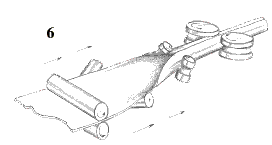 Schwinn also used coil strips of steel to produce its own tubing. The strips were fed through a series of rollers which shaped and sized them and prepared them for the final rollers, which passed an electric current to the edges. This was a continuous process, so immediately after welding, the bulk tubing was cut to the appropriate lengths. Having the capacity to make tubing was crucial to the viability of E/F frames, as the savings over buying pre-made tubing were enormous. Material handling, transportation and scrap costs were slashed to the bone by bringing this operation in house. (Figure 6)
Schwinn also used coil strips of steel to produce its own tubing. The strips were fed through a series of rollers which shaped and sized them and prepared them for the final rollers, which passed an electric current to the edges. This was a continuous process, so immediately after welding, the bulk tubing was cut to the appropriate lengths. Having the capacity to make tubing was crucial to the viability of E/F frames, as the savings over buying pre-made tubing were enormous. Material handling, transportation and scrap costs were slashed to the bone by bringing this operation in house. (Figure 6)
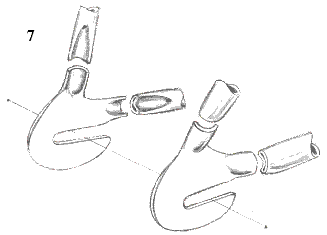 The chainstay and seatstay to dropout joint posed a unique challenge to Schwinn engineers. A typical chainstay-seatstay-dropout joint requires slotting the tube ends and inserting the ends of a dropout into the tube and brazing them together. This process had to be greatly speeded up. Since the E/F process works on edge-to-edge contact, Schwinn engineers had to create edges on the seatstays and chainstays. To do that, one end of the tube was stamped into a crescent shape. The dropout, again formed from coil strip stock, had its end tabs formed into the same crescent shape. The resultant matchup of the formed dropout. tabs and tube ends made E/F possible on this otherwise labor-intensive joint. (Figure 7)
The chainstay and seatstay to dropout joint posed a unique challenge to Schwinn engineers. A typical chainstay-seatstay-dropout joint requires slotting the tube ends and inserting the ends of a dropout into the tube and brazing them together. This process had to be greatly speeded up. Since the E/F process works on edge-to-edge contact, Schwinn engineers had to create edges on the seatstays and chainstays. To do that, one end of the tube was stamped into a crescent shape. The dropout, again formed from coil strip stock, had its end tabs formed into the same crescent shape. The resultant matchup of the formed dropout. tabs and tube ends made E/F possible on this otherwise labor-intensive joint. (Figure 7)
After all these processes, the head tube, BB tubes and rear end subassemblies were ready to be joined into an E/F frame. The processes just described produced the building blocks and potential cost savings for the frames, but just as important to the ultimate success was the sequence of joints produced. Since the slag from each joint had to be removed quickly to keep costs in line, the joint sequence was designed to assure maximum efficiency in the polishing operations.
![]()
![]()
Joining the top and down tubes to the head tube was the most dramatic operation, and was often pictured in the Schwinn catalog. These tubes were clamped nearly together in copper jaws, and once the electric arc was struck, the down tube was pushed into the head tube. Nearly 3/16" of steel from the head and downtube was burned away, leaving a circumferential ring of slag. Then this new subassembly was put into a lathe, and the slag was machined off. The seat mast and bottom bracket were likewise joined and cleaned up on a lathe. Using a lathe to clean up these joints required the parts to be aligned almost perfectly.
An interesting side note: If you look closely at the upper end of a Varsity seat tube, you'll see a subtle tapering of the 1" O.D. on the top 4-6 inches. This assured a good fit-up with the unique Schwinn seat post diameter.
Next, the top tube was E/F'd to the head tube. While the welding operation was the same as for the down tube, the clean up operation was not. Instead, the workers cleaned off the slag by hand, using scarfing pliers--a tool with a pair of 3' long steel handles and a jaw which wrapped around the weld joint. By rotating the pliers, the slag was cut down to the diameter of the jaw, and further cleanup and blending was done on a belt sander. To complete the front harp, the down tube was E/F'd to the BB shell and cleaned up with scarfing pliers.
Schwinn engineers went to great lengths to create joints suitable for E/F, but one--the top tube to seat tube joint-- always escaped their best efforts. Remember, E/F is an edge-to-edge process, and this joint had only one edge, on the end of the top tube. For years this joint was hand brazed and polished, but finally an economical solution was found. When the end of the tube was mitered ("notched" in Schwinn parlance) its edges were also flared to fit up to the seat tube. The frame was placed in a fixture with the head pointing upward. Surrounding the seat joint were induction coils that heated the seat joint rapidly, melting a preplaced silver brazing wire. Yes, your Varsity had a lugged, silver brazed joint!
The E/F process also joined the chainstay to the remaining two protrusions on the bottom bracket, but those joints and the seam on the BB shell itself were never cleaned up as much as the other joints. There was always visible slag ring around each chainstay where it met the BB, and across the bottom of the BB. shell. That may have been because these joints were not obvious, or maybe there were concerns about compromising strength in these areas with excessive cleanup. Whatever the case, the slag ring around the chainstays is the only visible clue to how the frames were made.
Just as with the seat joint, various methods were used to create the final seatstay to seat mast joint, which, over the years, had been either welded or hand brazed. The final solution was a simple form of projection welding, using the small tangent of the seat tube to the seat stay to pass a high electric current which actually caused the tubes to melt together. The same method attached rear bridges, cable stops and the famous Schwinn kickstand housing.
It may seem as if these frames were very time-consuming, but many of the operations took no longer than the stroke of a punch press or an electric jolt of just a few seconds--a small fraction of the time needed to produce even an automatically-brazed frame. The time savings explained the Schwinn economic miracle.
![]()
![]()
I am often asked if the E/F frames could have been updated and continued in production. Marketing issues aside, I believe great advances could have been made, but the necessary metallurgical advances, namely the HSLA (high strength, low alloy; Nivachrome is an example) family of steels, came too late. These steels emerged from the auto industry in the late 1970's as car makers tried to reduce weight and increase strength to comply with federal mileage, emission, and safety standards. HSLA steels combine properties that before had been seemingly mutually exclusive. They're far stronger than the 1010 grade steels used in E/F frames, and they maintain their high elongation (meaning, they don't become brittle), so they're ideal for stampings, while their low-enough carbon content assures excellent weldability. The unique combination of high strength, high elongation, and excellent weldability would have allowed the stamping operations of the head and bottom bracket shells, and been well suited for E/F. The result would have been truly significant weight savings. Combined with a built-in aluminum kickstand, (which was a project under consideration at Schwinn) and a three piece crank, how does a sub thirty pound Varsity sound? (With more aluminum parts it could have weighed twenty-four.)
These changes were not to be, however. The E/F machinery is gone, and the people who knew how to operate it have scattered. When the factory was torn down, many of the fixtures were scrapped. The welding equipment was sold, no doubt being used to make some sort of tubular product. A very unique bicycle manufacturing process, one that provided millions of bicycles ridden and still being ridden perhaps billions of fun-filled miles, has slipped into oblivion. Since the process will never be revived, all we can do is look back and preserve the process in our minds, so those wonderful, and still plentiful, bicycles and the visionary engineers who created them retain their rightful place in bicycle history.
My thanks to Frank Brilando, former Senior Vice President of Engineering at Schwinn, for his incredible contributions to the Schwinn Bicycle Co. and bicycle design. We all owe him so much, and his many insights helped me write this article.
Marc started a custom frame building business (Phydeaux) in 1974, and then joined Schwinn five years later, in 1979. At the time he had no connection with nor interest in the Paramount division--his interest in Schwinn was to learn new things, including all about production building and the workings of a large factory. But his building skills were well-known, so he was called upon to build some custom frames for a few celebrities, and "got sucked into it." He later became Paramount Program manager, and that lead to his position as manager of the Bicycle Products Division. When Schwinn closed its Greenville, Mississippi factory in 1991, Marc and Richard Schwinn worked on a plan to rejuvenate and expand the Paramount division--which was already off by itself in Waterford, Wisconsin. Then Schwinn filed for bankruptcy and went up for sale. An investment group (Zell-Chilmark) bought Schwinn, but they didn't want the Paramount division so Richard and Debra Schwinn and Marc bought it, and all's well.
![]()
![]()
![]()
Last Updated: by Harriet Fell